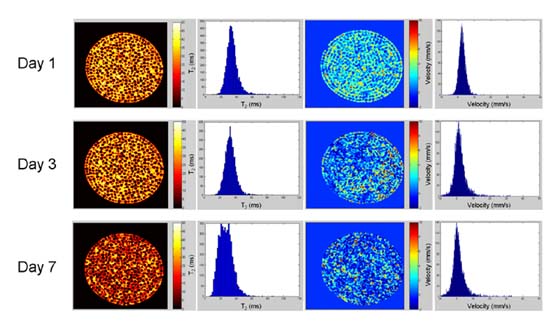Research Projects
Biofouled Porous Media - Pore Connectivity
Recent two dimensional nuclear magnetic resonance (NMR) techniques access exchange in pore structures through surface relaxation and diffusion based relaxation. This research applies these techniques to measure pore changes due to biofilm growth and the impact this growth has on diffusion transport. The porous media used in this study are model beadpacks constructed from borosilicate glass beads with diameters approximately 100 um. This research shows that through changes in the relaxation rates, NMR can be used to verify biofilm growth in porous media.
Biofouled Porous Media - Pore Scale Transport
Perturbations due to biofouling in capillaries were detected in 3-D velocity maps in each of the three square capillary sizes (2mm, 0.9mm, and 0.5mm i.d.). Similar flow maps generated in a clean square capillary show only an axial component. Study showed significant secondary flows present in the 0.9mm i.d. capillary, on the scale of 20% of the bulk fluid flow. Since this is the 'standard 1mm' size capillary used in many laboratory bioreactors to investigate biofilm properties and biofouling problems, it is imperative to understand how these enhanced flows impact the system's transport.
Porous Biofilm Biopolymer Matrix
Nuclear Magnetic Resonance (NMR) is a noninvasive and nondestructive tool able to access several observable quantities in biofilms such as chemical composition, diffusion, and macroscale structure and transport. Pulsed Gradient Spin Echo (PGSE) NMR techniques were used to measure spectrally resolved biomacromolecular diffusion in biofilm biomass, extending previous research on spectrally resolved diffusion in biofilms. The dominant water signal was nulled in order to view the spectra of components such as the rotationally mobile carbohydrates, DNA and proteins. Diffusion data for the major constituents obtained from each of these spectral peaks demonstrate that the biomass of the biofilm contains both a fast and slow diffusion component. The dependence of diffusion on antimicrobial and environmental challenges suggests the polymer molecular dynamics measured by NMR are a sensitive indicator of biofilm function.

Velocity Map Compared to T2 Map as Function of Biofilm Growth
